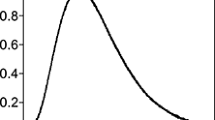Summary
An analytical study has been made to determine the heat transfer characteristics of a stagnation point flow in which there are temperature-dependent heat sources or sinks. Results have been obtained for both strong and weak sources or sinks for a Prandtl number of 0.7. An analytical method, applicable to all Prandtl numbers, was utilized which circumvented the need for extensive numerical solutions and which, at the same time, provided a closed-form representation for the heat transfer. A few numerical solutions were carried out to verify the method.
Similar content being viewed by others
Abbreviations
- a i :
-
constants depending on Prandtl number
- c p :
-
specific heat at constant pressure
- f :
-
dimensionless velocity variable
- g :
-
function defined by equation (13)
- g n :
-
functions of η (n=1, 2, 3,...)
- k :
-
thermal conductivity
- Pr :
-
Prandtl number, μc p /k
- q :
-
heat transfer rate per unit area at surface
- Q :
-
heat flux parameter, q/k(u 1/ν)1/2
- S :
-
rate of heat generation or removal per unit volume (divided by ρc p )
- T :
-
static temperature; T w , wall temperature; T ∞, free-stream temperature
- u 1 :
-
proportionality constant for free-stream velocity
- U ∞ :
-
free-stream velocity
- v :
-
normal velocity component
- x :
-
coordinate measuring distance along surface from stagnation point
- y :
-
coordinate measuring distance normal to surface
- β :
-
heat generation parameter, equation (3)
- η :
-
dimensionless normal coordinate, \(y\sqrt {u_1 /v} \)
- θ :
-
dimensionless temperature
- θ n :
-
functions of η (n=1, 2, 3,...)
- μ :
-
absolute viscosity
- ν :
-
kinematic viscosity
- ρ :
-
density
References
Low, G. M., J. Aero. Sci. 22 (1955) 329.
Chambré, P. L., Appl. Sci. Res. A6 (1957) 393.
Lees, L., Jet Propulsion 26 (1956) 259.
Fay, J. A., and F. R. Riddell, J. Aero. Sci. 25 (1958) 73.
Hartnett, J. P. and E. R. G. Eckert, Mass Transfer Cooling with Combustion in a Laminar Boundary Layer, Proc. 1958 Heat Transfer and Fluid Mechanics Institute, Stanford University Press, 1958, pp. 56–68.
Rosenz weig, M. L., The Response of the Laminar Boundary Layer to Impulsive Motions, Ph. D. Dissertation in Aeronautical Engineering, Cornell University, 1959, (also available as TN-59-92, ASTIA No. 210-182.)
Donoughe, P. L. and J. N. B. Livingood, Exact Solutions of the Laminar Boundary Layer with Constant Property Values for Porous Wall with Variable Temperature, NACA Report 1229, 1955.
Rojansky, V., Introductory Quantum Mechanics, Prentice-Hall, Inc., New York, New York 1946, pp. 186–187.
Brown, W. B. and P. L. Donoughe, Tables of Exact Laminar-Boundary-Layer Solutions when the Wall is Porous and Fluid Properties are Variable, NACA TN 2479, 1951.
Author information
Authors and Affiliations
Rights and permissions
About this article
Cite this article
Sparrow, E.M., Cess, R.D. Temperature-dependent heat sources or sinks in a stagnation point flow. Appl. sci. Res. 10, 185 (1961). https://doi.org/10.1007/BF00411912
Received:
DOI: https://doi.org/10.1007/BF00411912



